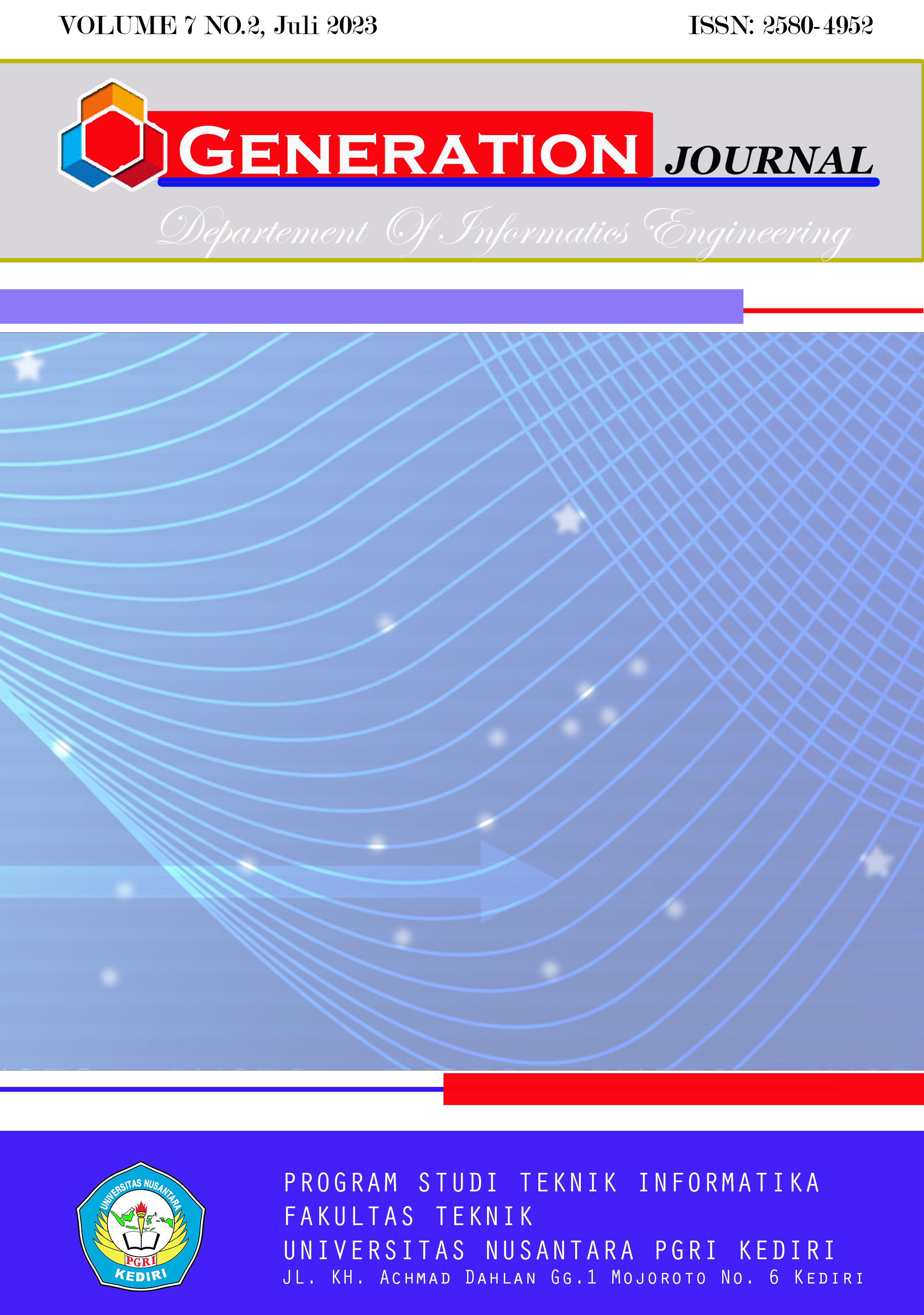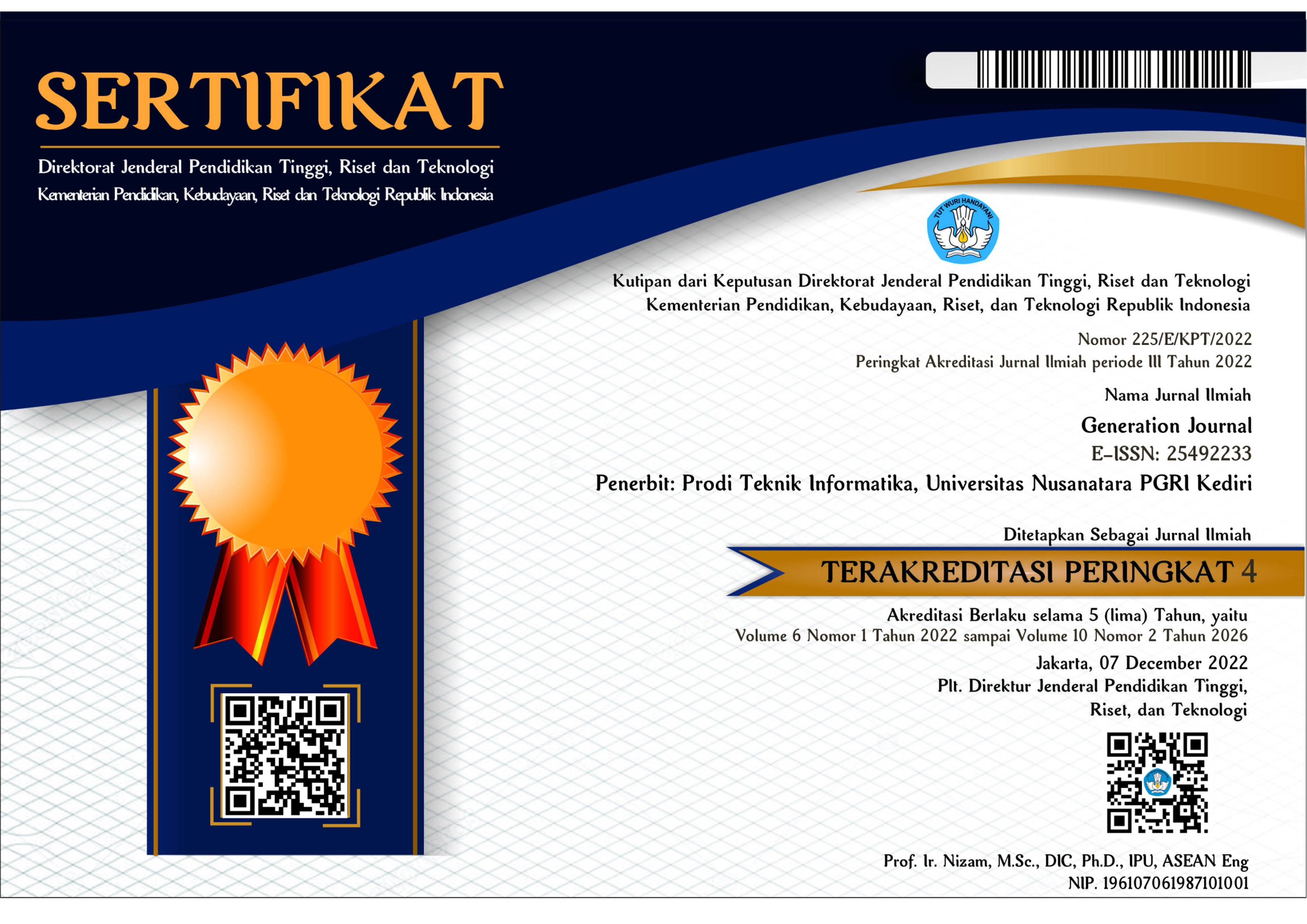Sistem Pakar Penyakit Telinga Menggunakan Metode Naïve Bayes
DOI:
https://doi.org/10.29407/gj.v7i2.19991Keywords:
Expert system, Diseases of the ear, Naïve BayesAbstract
An expert system is a type of artificial intelligence application that is used to tackle complex problems that require specialized knowledge. Expert systems can be used in a variety of disciplines, including healthcare, finance, and manufacturing. The aim of this study was to apply the Nave Bayes approach in a website-based ear illness diagnostic system and to determine its accuracy in an expert system for diagnosing ear disease. The naive Bayes approach is implemented in this research because it may assume that each symptom is independent of one another and can thus be used to assess the probability of a condition based on the symptoms that emerge. The results of this study show that the expert system for diagnosing ear disease using the Nave Bayes method is built on a website using the PHP programming language and the database maintained by MySQL, and this application has been tested 10 times, with 9 test data appropriate and 1 test data not appropriate. As a result of testing this application, the accuracy value obtained is 90%.
References
] A. H. Maidabara, A. S. Ahmadu, Y. M. Malgwi, and D. Ibrahim, “EXPERT SYSTEM FOR DIAGNOSIS OF MALARIA AND TYPHOID,” Comput. Sci. IT Res. J., vol. 2, no. 1, pp. 1–15, 2021, doi: 10.51594/csitrj.v2i1.274.
M. Pal and S. Parija, “Prediction of Heart Diseases using Random Forest,” 2021. doi: 10.1088/1742-6596/1817/1/012009.
R. A. D. Yunas, A. Triayudi, and I. D. Sholihati, “Implementasi Sistem Pakar untuk Mendeteksi Virus Covid-19 dengan Perbandingan Metode Naïve Bayes dan Certainty Factor,” J. JTIK (Jurnal Teknol. Inf. dan Komunikasi), vol. 5, no. 3, pp. 338–344, 2021.
D. S. Salsabila and R. Tanamal, “Design of Expert System for Digestive Diseases Identification Using Naïve Bayes Methodology for iOS-Based Application,” Inf. J. Ilm. Bid. Teknol. Inf. dan Komun., vol. 5, pp. 92–98, 2020, doi: http://dx.doi.org/10.25139/inform.v0i1.2771.
E. A. Algehyne, M. L. Jibril, N. A. Algehainy, O. A. Alamri, and A. K. Alzahrani, “Fuzzy Neural Network Expert System with an Improved Gini Index Random Forest-Based Feature Importance Measure Algorithm for Early Diagnosis of Breast Cancer in Saudi Arabia,” big data Cogn. Comput. Artic., vol. 6, no. 13, 2022, doi: https://doi.org/10.3390/ bdcc6010013.
B. Kaur, H. Sadawarti, and J. Singla, “A Comprehensive Review of Medical Expert Systems for Diagnosis of Chronic Kidney Diseases,” in Second International Conference on Smart Systems and Inventive Technology (ICSSIT 2019), 2019, no. Icssit, pp. 1008–1013.
H. Z. rizky Robby, “Sistem Pakar Menentukan Penyakit Hipertensi Pada,” Sist. Pakar Menentukan Penyakit Hipertens. Pada Ibu Hamil Di RSUD Adjidarmo Rangkas Bitung Provinsi Banten, vol. 09, pp. 30–34, 2020.
F. Karim and G. W. Nurcahyo, “Sistem Pakar dalam Mengidentifikasi Gejala Stroke Menggunakan Metode Naive Bayes,” J. Sistim Inf. dan Teknol., vol. 3, pp. 221–226, 2021, doi: 10.37034/jsisfotek.v3i4.69.
Khoironi, A. Rosyid, and M. Azmi, “Sistem pakar diagnosa penyakit ginjal dengan menggunakan algoritma bayes,” TEKNIMEDIA, vol. 1, no. 2, pp. 39–44, 2020.
T. Arifin and D. Ariesta, “PREDIKSI PENYAKIT GINJAL KRONIS MENGGUNAKAN ALGORITMA NAIVE BAYES CLASSIFIER BERBASIS PARTICLE SWARM OPTIMIZATION,” J. Tekno Insentif |, vol. 13, no. 1, pp. 26–30, 2019, doi: https://doi.org/10.36787/jti.v13i1.97.
Harmayani and L. Sitorus, “Diagnosa Penyakit Ginjal Kronis Menggunakan Metode Klasifikasi Naïve Bayes,” J. MEDIA Inform. BUDIDARMA, vol. 4, no. 3, pp. 850–854, 2020, doi: 10.30865/mib.v4i3.2292.
V. Sabarinathan and V. Sugumaran, “Diagnosis of Heart Disease Using Decision Tree Diagnosis of Heart Disease Using Decision Tree,” Int. J. Res. Comput. Appl. Inf. Technol., vol. 2, no. 6, pp. 74–79, 2016.
A. Imran, “IMPLEMENTASI SISTEM PAKAR DIAGNOSA PENYAKIT EPISTAKSIS PADA MANUSIA MENGGUNAKAN METODE HYBRID CASE BASED DAN RULE BASED REASONING,” J. Maj. Ilm. Inf. dan Teknol. Ilm., vol. 7, no. 1, pp. 85–92, 2019.
David, “Penerapan Rule Based Forward Chaining pada Sistem Pakar untuk Diagnosa Penyakit Kulit,” in Konferensi Nasional Sistem Informasi 2018, 2018, pp. 8–9.
P. Suryachandra and P. V. S. Reddy, “COMPARISON OF MACHINE LEARNING ALGORITHMS FOR BREAST CANCER,” 2016. doi: 10.1109/INVENTIVE.2016.7830090.
C. M. S. Ramdani, A. N. Rachman, and R. Setiawan, “Comparison of the Multinomial Naive Bayes Algorithm and Decision Tree with the Application of AdaBoost in Sentiment Analysis Reviews PeduliLindungi Application,” Int. J. Inf. Syst. Technol., vol. 6, no. 158, pp. 419–430, 2022.
C. Shah and A. Jivani, G., “Comparison of Data Mining Classification Algorithms for Breast Cancer Prediction,” in 2013 Fourth International Conference on Computing, Communications and Networking Technologies (ICCCNT), 2013, pp. 4–7. doi: 10.1109/ICCCNT.2013.6726477.
M. Bilal, H. Israr, M. Shahid, and A. Khan, “Sentiment classification of Roman-Urdu opinions using Naı ¨ ve Bayesian , Decision Tree and KNN classification techniques,” J. King Saud Univ. - Comput. Inf. Sci., vol. 28, no. 3, pp. 330–344, 2016, doi: 10.1016/j.jksuci.2015.11.003.
D. Soria, J. M. Garibaldi, E. Biganzoli, and I. O. Ellis, “A Comparison of Three Different Methods for Classification of Breast Cancer Data,” in 2008 Seventh International Conference on Machine Learning and Applications, 2008, pp. 619–624. doi: 10.1109/ICMLA.2008.97.
C. Zhang, W. Zuo, T. Peng, and F. He, “Sentiment Classification for Chinese Reviews Using Machine Learning Methods Based on String Kernel,” in Third 2008 International Conference on Convergence and Hybrid Information Technology Sentiment, 2008, pp. 909–914. doi: 10.1109/ICCIT.2008.51.
D. T. LAROSE and C. D. LAROSE, DISCOVERING KNOWLEDGE IN DATA An Introduction to Data Mining, Second. Hoboken, New Jersey: John Wiley & Sons, Inc., 2014.
A. Gupte, S. Joshi, P. Gadgul, and A. Kadam, “Comparative Study of Classification Algorithms used in Sentiment Analysis,” Int. J. Comput. Sci. Inf. Technol., vol. 5, no. 5, pp. 6261–6264, 2014.
Hartatik, M. B. Tamam, and A. Styanto, “Prediction for Diagnosing Liver Disease in Patients using KNN and Naïve Bayes Algorithms,” in 2nd International Conference on Cybernatics and Intelligent Syatem (ICORIS), 2020, pp. 1–5. doi: 10.1109/ICORIS50180.2020.9320797.
K. Ain, H. B. Hidayati, and O. A. Nastiti, “Expert System for Stroke Classification Using Naive Bayes Classifier and Certainty Factor as Diagnosis Supporting Device Expert System for Stroke Classification Using Naive Bayes Classifier and Certainty Factor as Diagnosis Supporting Device,” 2020. doi: 10.1088/1742-6596/1445/1/012026.
S. Hossain, D. Sarma, F. Tuj-johora, J. Bushra, S. Sen, and M. Taher, “A Belief Rule Based Expert System to Predict Student Performance under Uncertainty,” in 2019 22nd International Conference on Computer and Information Technology (ICCIT), 2019, no. December, pp. 18–20.
A. Junaidi, N. Dewi, T. Baidawi, S. Agustiani, Y. T. Arifin, and H. T. Sihotang, “Expert System Of Syzygium Aqueum Disease Diagnose Using Bayes Method Expert System Of Syzygium Aqueum Disease Diagnose Using Bayes Method,” in ICAISD 2020 (Journal of Physics: Conference Series), 2020, pp. 0–6. doi: 10.1088/1742-6596/1641/1/012097.
F. Dwiramadhan, M. I. Wahyuddin, and D. Hidayatullah, “Sistem Pakar Diagnosa Penyakit Kulit Kucing Menggunakan Metode Naive Bayes Berbasis Web,” J. JTIK (Jurnal Teknol. Inf. dan Komunikasi), vol. 6, no. 3, pp. 429–437, 2022, doi: 10.35870/jtik.v6i3.466.
Budianto, I. Fitri, and Winarsih, “Expert System for Early Detection of Disease in Corn Plant Using Naive Bayes Method,” J. Mantik, vol. 3, no. 4, pp. 308–317, 2020, [Online]. Available: https://iocscience.org/ejournal/index.php/mantik/index%0AExpert
R. Syahputra, A. Triayudi, and I. D. Sholihati, “Application Of Expert System To Diagnose Pests And Diseases In Coffee Plant Using Web-Based Naïve Bayes,” J. Mantik, vol. 3, no. 4, pp. 383–392, 2020, [Online]. Available: https://iocscience.org/ejournal/index.php/mantik/index
D. Silahudin, Henderi, and A. Holidin, “Model Expert System for Diagnosis of Covid-19 Using Naïve Bayes Classifier Model Expert System for Diagnosis of Covid-19 Using Naïve Bayes Classifier,” 2020. doi: 10.1088/1757-899X/1007/1/012067.
W. E. Sari, Y. E. Kurniawati, and P. I. Santosa, “Papaya Disease Detection Using Fuzzy Naïve Bayes Classifier,” in 3rd International Smeinar on Research of Information Technology and Intelligent Systems (ISRITI), 2020, pp. 42–47.
Y. B. Widodo, S. A. Anggraeini, and T. Sutabri, “Perancangan Sistem Pakar Diagnosis Penyakit Diabetes Berbasis Web Menggunakan Algoritma Naive Bayes,” J. Teknlogi Inform. dan Komput. MH. Thamrin, vol. 7, no. 1, pp. 112–123, 2021.
N. S. B. Sembiring, E. Ginting, M. Fauzi, Yudi, F. Tambunan, and E. V. Haryanto, “An Expert System To Diagnose Herpes Zoster Disease Using Bayes Theorem,” in The 7th International Conference on Cyber and IT Service Management (CITSM 2019), 2019, pp. 6–8.
E. Fitriani, P. H. Susilo, A. S. Budi, T. Informatika, F. Teknik, and U. I. Lamongan, “Sistem Cerdas Prediksi Prestasi Belajar Menggunakan Algoritma Naive Bayes di MA Sains Roudlotul Qur ’ an Lamongan,” Gener. J., vol. 6, no. 1, pp. 58–67, 2022.
Y. B. Utomo and G. W. Harsanto, “Penerapan Metode Certainty Factor Dan Naïve Bayes Untuk Mendiagnosa Penyakit Akibat Gigitan Nyamuk,” Gener. J., vol. 4, no. 2, pp. 49–60, 2020.
T. F. Rahmadanti, M. Jajuli, I. Purnamasari, T. Informatika, F. I. Komputer, and U. S. Karawang, “Klasifikasi Pengguna Shopee Berdasarkan Promosi Menggunakan Naïve Bayes,” Gener. J., vol. 5, no. 2, pp. 81–90, 2020.
F. Ramadhana and U. Nasional, “Aplikasi sistem pakar untuk mendiagnosa penyakit ispa menggunakan metode naive bayes berbasis website,” STRING (Satuan Tulisan Ris. dan Inov. Teknol., vol. 4, no. 3, pp. 320–329, 2020.
Downloads
Published
Issue
Section
License
Authors who publish with this journal agree to the following terms:
- Copyright on any article is retained by the author(s).
- The author grants the journal, the right of first publication with the work simultaneously licensed under a Creative Commons Attribution License that allows others to share the work with an acknowledgment of the work’s authorship and initial publication in this journal.
- Authors are able to enter into separate, additional contractual arrangements for the non-exclusive distribution of the journal’s published version of the work (e.g., post it to an institutional repository or publish it in a book), with an acknowledgment of its initial publication in this journal.
- Authors are permitted and encouraged to post their work online (e.g., in institutional repositories or on their website) prior to and during the submission process, as it can lead to productive exchanges, as well as earlier and greater citation of published work.
- The article and any associated published material is distributed under the Creative Commons Attribution-ShareAlike 4.0 International License














